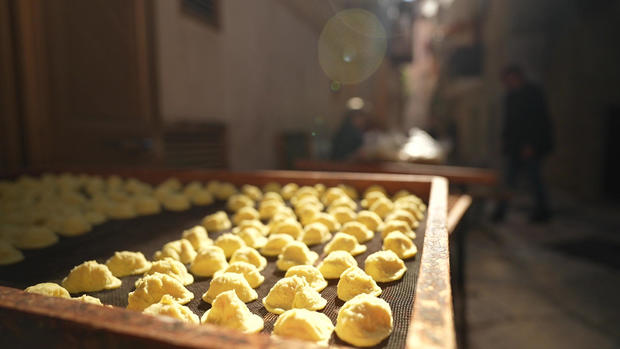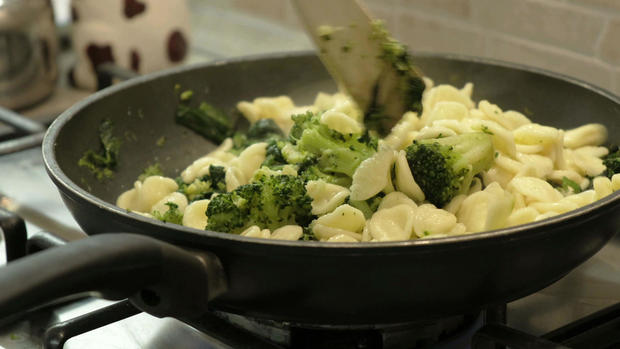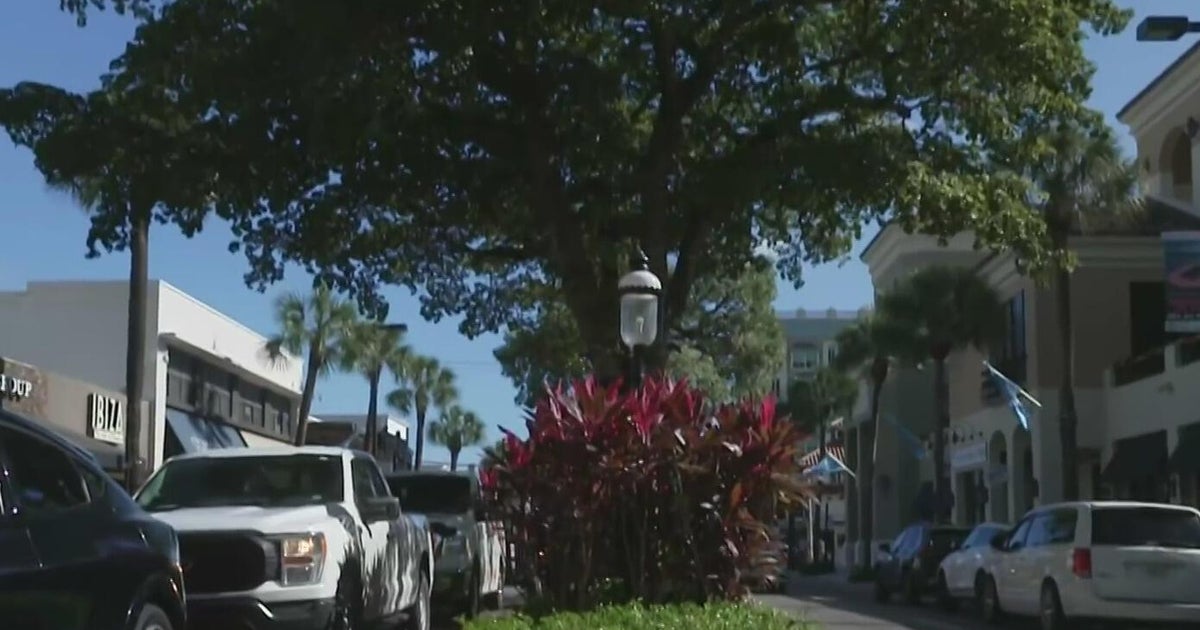Orecchiette: The art of pasta
The scene could not be much more Italian: a Vespa, laundry on the line, and women in the street making pasta. To know which part of Italy, though, just look at the shape they're making – that is, if you can see it. Nunzia Caputo's hands move so quickly that we've slowed-down the video to see her forming orecchiette, which means "little ears."
It's the pasta of Puglia, a region known for olive trees, distinctive homes called trulli, and orecchiette, which Caputo says she's been making since she was six. Good thing she sees it as more art than work.
"Because you see this mass transform," she told correspondent Seth Doane, "it's magic in your hands."
This pasta gleams like treasure on these streets where a number of women make orecchiette. Caputo is the fourth generation in her family to do this. Too bad there won't be a fifth – she has sons. "The men here drink beer; they do not make orecchiette," she lamented.
"What a pity!" said Doane.
Elizabeth Minchilli has written books on eating and dining out in Italy, and she and her daughter, Sophie, offer "Week in Italy" food tours to visitors. In the region's capital, Bari, they stop where Caputo has set up shop (or, well, stage). Her show offers mystery and head-shaking delight.
"There's this one woman, Nunzia, and we've been going there, you know, for the last 20 years or so, buying our orecchiette from her and actually learning how to make it," Minchilli said.
"Can you make it?" Doane asked.
"Are we being recorded?" she laughed.
"You're used to seeing pasta made in a pastificio inside, indoors. Why on the street?"
"Originally the pasta that we think of as the original pasta was dried on the street. They used the sun and the wind."
Caputo said passers-by once asked her mother if they could buy some pasta, and a business was born.
At Ancora Pastificio, Michele Fiore showed Doane how, in Bari, selling just one size of orecchiette won't do: we counted seven, which he'd better have in stock if he wants to keep his customers, who would tell Fiore, "If you don't have this small, okay. Today, don't eat."
"Really? They'll leave if it's not the right size orecchiette?"
"Yes!"
When asked if one needs all these different sizes of orecchiette, Minchilli replied, "Yes! Of course, you do!" She explained different sizes go with different sauces.
Doane asked, "How does a type of pasta become so connected with a region of Italy?"
"Well, I think it has to do with every region, every town, has their own traditions," she said. "And they start it with certain kinds of flour. They start it with certain economic conditions. And then they have the ingredients that go with that pasta. So, in the north, you have more cream and more butter and more cheese. Whereas in the south, it's a little bit poorer. So, you have more vegetables."
"Where do you rank orecchiette on your list of pastas as a cook?"
"Oh, I'm not going to go, I'm not going to weigh in on this!" Minchilli laughed. "I love all pastas equally, from all regions!"
A dash of diplomacy can also be a key ingredient in a country where food means so much.
Recipe:
- Orecchiette con le cime di rapa (from Elizabeth Minchilli)
For more info:
- Nunzia Caputo, Bari (Instagram)
- Pastificio Ancora & Fiore, Bari
- elizabethminchilli.com
- "The Italian Table: Creating Festive Meals for Family and Friends" by Elizabeth Minchilli (Rizzoli), in Hardcover and eBook formats, available via Amazon and Indiebound
Story produced by Sabina Castelfranco and Aria Shavelson. Editor: Emanuele Secci.
Check out the "Sunday Morning" 2021 Food Issue Recipe Index for more menu suggestions, from all of the chefs, cookbook authors, flood writers and restaurateurs featured on our program, as well as the writers and editors of New York Times Cooking.









